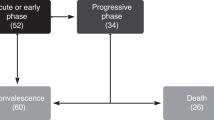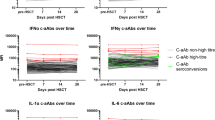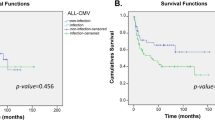Abstract
Mannan-binding lectin (MBL) deficiency is determined by MBL gene polymorphisms and is associated with an increased infection risk. To clarify the role of MBL in Allo-SCT, 131 recipients–donors were analysed. MBL genotypes were determined by PCR and heteroduplex analyses, MBL serum levels by ELISA, and MBL oligomers by western blotting. MBL levels <400 ng/ml were associated with increased susceptibility to fungal pneumonia (7/12 vs 35/111; P=0.04, adjusted P=0.002), HSV/VZV (7/12 vs 26/111; P=0.03), CMV reactivation and acute GVHD. Donor genotypes had no influence. Pre-SCT MBL levels corresponded to recipients’ genotypes (P<0.001), changed significantly post-SCT, but were not influenced by donors’ genotypes. MBL oligomer profiles were similar pre-/post-SCT. Cultured CD34+ cells were found not to synthesise MBL. In conclusion, low MBL levels pre-transplant predisposed patients to sepsis, fungal and viral infection. Donors’ MBL genotypes did not influence infection rates. Prospective studies should clarify the importance of MBL as a prelude for MBL replacement after SCT.
This is a preview of subscription content, access via your institution
Access options
Subscribe to this journal
Receive 12 print issues and online access
$259.00 per year
only $21.58 per issue
Buy this article
- Purchase on Springer Link
- Instant access to full article PDF
Prices may be subject to local taxes which are calculated during checkout




Similar content being viewed by others
References
Turner MW . Mannose-binding lectin: the pluripotent molecule of the innate immune system. Immunol Today 1996; 17: 532–540.
Minchinton RM, Dean MM, Clark TR, Heatley S, Mullighan CG . Analysis of the relationship between mannose-binding lectin (MBL) genotype, MBL levels and function in an Australian blood donor population. Scand J Immunol 2002; 56: 630–641.
Sastry K, Herman GA, Day L, Deignan E, Bruns G, Morton CC et al. The human mannose-binding protein gene. Exon structure reveals its evolutionary relationship to a human pulmonary surfactant gene and localization to chromosome 10. J Exp Med 1989; 170: 1175–1189.
Smithson A, Munoz A, Suarez B, Soto SM, Perello R, Soriano A et al. Association between mannose-binding lectin deficiency and septic shock following acute pyelonephritis due to Escherichia coli. Clin Vaccine Immunol 2007; 14: 256–261.
Garred P, Strom J, Quist L, Taaning E, Madsen HO . Association of mannose-binding lectin polymorphisms with sepsis and fatal outcome, in patients with systemic inflammatory response syndrome. J Infect Dis 2003; 188: 1394–1403.
Vekemans M, Robinson J, Georgala A, Heymans C, Muanza F, Paesmans M et al. Low mannose-binding lectin concentration is associated with severe infection in patients with hematological cancer who are undergoing chemotherapy. Clin Infect Dis 2007; 44: 1593–1601.
Schlapbach LJ, Aebi C, Otth M, Luethy AR, Leibundgut K, Hirt A et al. Serum levels of mannose-binding lectin and the risk of fever in neutropenia pediatric cancer patients. Pediatr Blood Cancer 2007; 49: 11–16.
Mullighan CG, Heatley SL, Danner S, Dean MM, Doherty K, Hahn U et al. Mannose-binding lectin status is associated with risk of major infection following myeloablative sibling allogeneic hematopoietic stem cell transplantation. Blood 2008; 112: 2120–2128.
Molle I, Peterslund NA, Thiel S, Steffensen R . MBL2 polymorphism and risk of severe infections in multiple myeloma patients receiving high-dose melphalan and autologous stem cell transplantation. Bone Marrow Transplant 2006; 38: 555–560.
Mullighan CG, Bardy PG . Mannose-binding lectin and infection following allogeneic hemopoietic stem cell transplantation. Leuk Lymphoma 2004; 45: 247–256.
Manuel O, Pascual M, Trendelenburg M, Meylan PR . Association between mannose-binding lectin deficiency and cytomegalovirus infection after kidney transplantation. Transplantation 2007; 83: 359–362.
Granell M, Urbano-Ispizua A, Suarez B, Rovira M, Fernandez-Aviles F, Martinez C et al. Mannan-binding lectin pathway deficiencies and invasive fungal infections following allogeneic stem cell transplantation. Exp Hematol 2006; 34: 1435–1441.
Berger SP, Roos A, Mallat MJ, Fujita T, de Fijter JW, Daha MR . Association between mannose-binding lectin levels and graft survival in kidney transplantation. Am J Transplant 2005; 5: 1361–1366.
Jack D, Bidwell J, Turner M, Wood N . Simultaneous genotyping for all three known structural mutations in the human mannose-binding lectin gene. Hum Mutat 1997; 9: 41–46.
Madsen HO, Garred P, Thiel S, Kurtzhals JA, Lamm LU, Ryder LP et al. Interplay between promoter and structural gene variants control basal serum level of mannan-binding protein. J Immunol 1995; 155: 3013–3020.
Lipscombe RJ, Sumiya M, Summerfield JA, Turner MW . Distinct physicochemical characteristics of human mannose binding protein expressed by individuals of differing genotype. Immunology 1995; 85: 660–667.
Fiegel HC, Lioznov MV, Cortes-Dericks L, Lange C, Kluth D, Fehse B et al. Liver-specific gene expression in cultured human hematopoietic stem cells. Stem Cells 2003; 21: 98–104.
Kibbler C . Defining invasive fungal infections in neutropenic or stem cell transplant patients. J Antimicrob Chemother 2005; 56 (Suppl 1): i12–i16.
Mullighan CG, Heatley S, Doherty K, Szabo F, Grigg A, Hughes TP et al. Mannose-binding lectin gene polymorphisms are associated with major infection following allogeneic hemopoietic stem cell transplantation. Blood 2002; 99: 3524–3529.
Kilpatrick DC, Stewart K, Allan EK, McLintock LA, Holyoake TL, Turner ML . Successful haemopoietic stem cell transplantation does not correct mannan-binding lectin deficiency. Bone Marrow Transplant 2005; 35: 179–181.
Bouwman LH, Roos A, Terpstra OT, de KP, van HB, Verspaget HW et al. Mannose binding lectin gene polymorphisms confer a major risk for severe infections after liver transplantation. Gastroenterology 2005; 129: 408–414.
Rocha V, Franco RF, Porcher R, Bittencourt H, Silva Jr WA, Latouche A et al. Host defense and inflammatory gene polymorphisms are associated with outcomes after HLA-identical sibling bone marrow transplantation. Blood 2002; 100: 3908–3918.
Ip WK, Lau YL . Role of mannose-binding lectin in the innate defense against Candida albicans: enhancement of complement activation, but lack of opsonic function, in phagocytosis by human dendritic cells. J Infect Dis 2004; 190: 632–640.
Turner MW, Johnson M, Booth C, Klein N, Rolland J, Davies J . Assays for human mannose-binding lectin. J Immunol Methods 2003; 276: 147–149.
Neth O, Jack DL, Johnson M, Klein NJ, Turner MW . Enhancement of complement activation and opsonophagocytosis by complexes of mannose-binding lectin with mannose-binding lectin-associated serine protease after binding to Staphylococcus aureus. J Immunol 2002; 169: 4430–4436.
Jack DL, Read RC, Tenner AJ, Frosch M, Turner MW, Klein NJ . Mannose-binding lectin regulates the inflammatory response of human professional phagocytes to Neisseria meningitidis serogroup B. J Infect Dis 2001; 184: 1152–1162.
Moller-Kristensen M, Ip WK, Shi L, Gowda LD, Hamblin MR, Thiel S et al. Deficiency of mannose-binding lectin greatly increases susceptibility to post burn infection with Pseudomonas aeruginosa. J Immunol 2006; 176: 1769–1775.
Allen ML, Peters MJ, Goldman A, Elliott M, James I, Callard R et al. Early postoperative monocyte deactivation predicts systemic inflammation and prolonged stay in pediatric cardiac intensive care. Crit Care Med 2002; 30: 1140–1145.
Acknowledgements
We thank the staff of the Infectious Diseases and Microbiology Unit for assistance with the MBL assays. RT was supported by a grant from the Agence nationale de recherches sur le sida et les hépatites virales (ANRS).
Author information
Authors and Affiliations
Corresponding author
Rights and permissions
About this article
Cite this article
Neth, O., Bacher, U., Das, P. et al. Influence of mannose-binding lectin genotypes and serostatus in allo-SCT: analysis of 131 recipients and donors. Bone Marrow Transplant 45, 13–19 (2010). https://doi.org/10.1038/bmt.2009.90
Received:
Revised:
Accepted:
Published:
Issue Date:
DOI: https://doi.org/10.1038/bmt.2009.90
Keywords
This article is cited by
-
Low pre-transplant levels of mannose-binding lectin are associated with viral infections and mortality after haematopoietic allogeneic stem cell transplantation
BMC Immunology (2019)
-
Association between TLR2/TLR4 gene polymorphisms and COPD phenotype in a Greek cohort
Herz (2017)
-
Association of mannose-binding lectin levels and invasive fungal disease in hematologic malignancy patients receiving myelosuppressive chemotherapy or allogeneic hematopoietic stem cell transplantation
Bone Marrow Transplantation (2016)
-
Mannan-binding lectin deficiency attenuates acute GvHD in pediatric hematopoietic stem cell transplantation
Bone Marrow Transplantation (2015)
-
Antifungal prophylaxis in hematopoietic stem cell transplant recipients: the unfinished tale of imperfect success
Bone Marrow Transplantation (2011)



